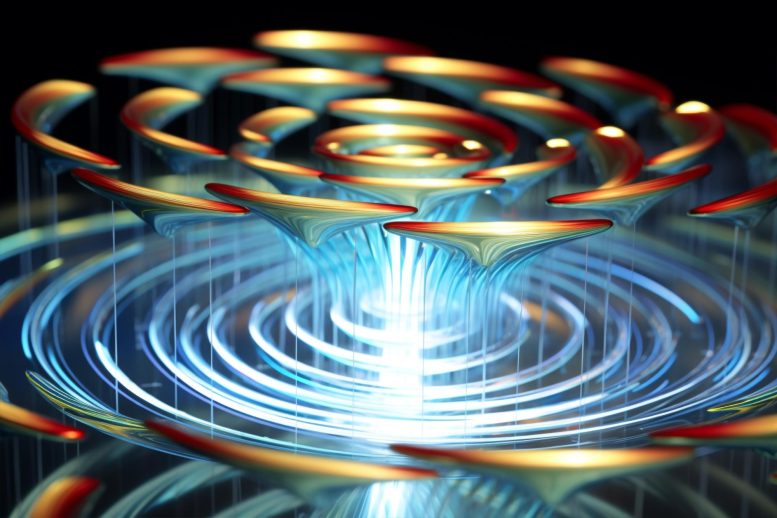
Twistronics, a novel field in quantum physics, involves stacking van der Waals materials to explore new quantum phenomena. Researchers at Purdue University have advanced this field by introducing quantum spin into twisted double bilayers of antiferromagnets, leading to tunable moiré magnetism. This breakthrough suggests new materials for spintronics and promises advancements in memory and spin-logic devices. Credit: SciTechDaily.com
Purdue quantum researchers twist double bilayers of an antiferromagnet to demonstrate tunable moiré magnetism.
Twistronics isn’t a new dance move, exercise equipment, or new music fad. No, it’s much cooler than any of that. It is an exciting new development in quantum physics and material science where van der Waals materials are stacked on top of each other in layers, like sheets of paper in a ream that can easily twist and rotate while remaining flat, and quantum physicists have used these stacks to discover intriguing quantum phenomena.
Adding the concept of quantum spin with twisted double bilayers of an antiferromagnet, it is possible to have tunable moiré magnetism. This suggests a new class of material platform for the next step in twistronics: spintronics. This new science could lead to promising memory and spin-logic devices, opening the world of physics up to a whole new avenue with spintronic applications.
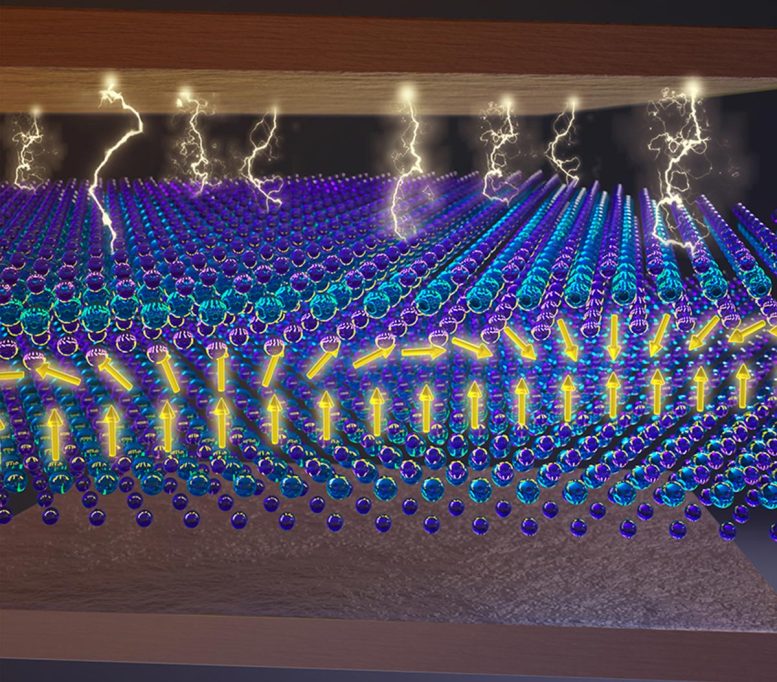
By twisting a van der Waals magnet, non-collinear magnetic states can emerge with significant electrical tunability. Credit: Ryan Allen, Second Bay Studios
A team of quantum physics and materials researchers at Purdue University has introduced the twist to control the spin degree of freedom, using CrI3, an interlayer-antiferromagnetic-coupled van der Waals (vdW) material, as their medium. They have published their findings, “Electrically tunable moiré magnetism in twisted double bilayers of chromium triiodide,” in Nature Electronics.
“In this study, we fabricated twisted double bilayer CrI3, that is, bilayer plus bilayer with a twist angle between them,” says Dr. Guanghui Cheng, co-lead author of the publication. “We report moiré magnetism with rich magnetic phases and significant tunability by the electrical method.”
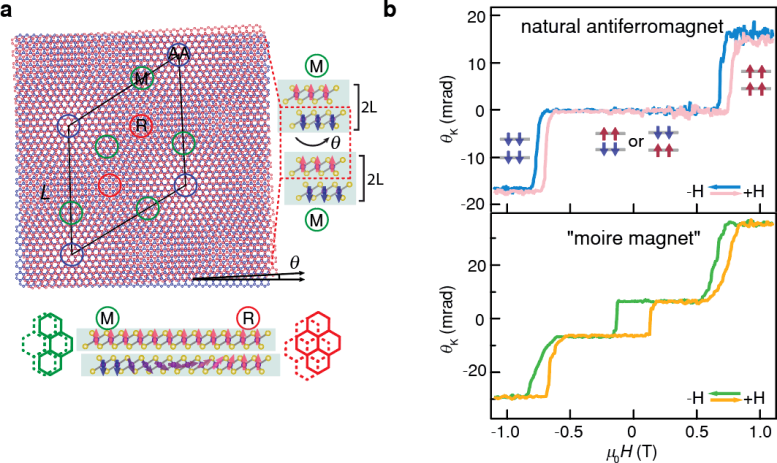
The moiré superlattice structure of twisted double bilayer (tDB) CrI3 and its magnetic behaviors probed by the magneto-optical-Kerr-effect (MOKE). Section a above shows the schematic of moiré superlattice fabricated by interlayer twisting. Bottom panel: a non-collinear magnetic state can emerge. Section b above shows MOKE results show the coexistence of antiferromagnetic (AFM) and ferromagnetic (FM) orders in the “moiré magnet” tDB CrI3 compared with the AFM orders in natural antiferromagnetic bilayer CrI3. Credit: Illustration by Guanghui Cheng and Yong P. Chen
“We stacked and twisted an antiferromagnet onto itself and voila got a ferromagnet,” says Chen. “This is also a striking example of the recently emerged area of ‘twisted’ or moiré magnetism in twisted 2D materials, where the twisting angle between the two layers gives a powerful tuning knob and changes the material property dramatically.”
“To fabricate twisted double bilayer CrI3, we tear up one part of bilayer CrI3, rotate and stack onto the other part, using the so-called tear-and-stack technique,” explains Cheng. “Through magneto-optical Kerr effect (MOKE) measurement, which is a sensitive tool to probe magnetic behavior down to a few atomic layers, we observed the coexistence of ferromagnetic and antiferromagnetic orders, which is the hallmark of moiré magnetism, and further demonstrated voltage-assisted magnetic switching. Such a moiré magnetism is a novel form of magnetism featuring spatially varying ferromagnetic and antiferromagnetic phases, alternating periodically according to the moiré superlattice.”
Twistronics up to this point have mainly focused on modulating electronic properties, such as twisted bilayer graphene. The Purdue team wanted to introduce the twist to spin degree of freedom and chose to use CrI3, an interlayer-antiferromagnetic-coupled vdW material. The result of stacked antiferromagnets twisting onto itself was made possible by having fabricated samples with different twisting angles. In other words, once fabricated, the twist angle of each device becomes fixed, and then MOKE measurements are performed.
Theoretical calculations for this experiment were performed by Upadhyaya and his team. This provided strong support for the observations arrived at by Chen’s team.
“Our theoretical calculations have revealed a rich phase diagram with non-collinear phases of TA-1DW, TA-2DW, TS-2DW, TS-4DW, etc.,” says Upadhyaya.
This research folds into an ongoing research avenue by Chen’s team. This work follows several related recent publications by the team related to novel physics and properties of “2D magnets,” such as “Emergence of electric-field-tunable interfacial ferromagnetism in 2D antiferromagnet heterostructures,” which was recently published in Nature Communications. This research avenue has exciting possibilities in the field of twistronics and spintronics.
“The identified moiré magnet suggests a new class of material platform for spintronics and magnetoelectronics,” says Chen. “The observed voltage-assisted magnetic switching and magnetoelectric effect may lead to promising memory and spin-logic devices. As a novel degree of freedom, the twist can be applicable to the vast range of homo/heterobilayers of vdW magnets, opening the opportunity to pursue new physics as well as spintronic applications.”
Reference: “Electrically tunable moiré magnetism in twisted double bilayers of chromium triiodide” by Guanghui Cheng, Mohammad Mushfiqur Rahman, Andres Llacsahuanga Allcca, Avinash Rustagi, Xingtao Liu, Lina Liu, Lei Fu, Yanglin Zhu, Zhiqiang Mao, Kenji Watanabe, Takashi Taniguchi, Pramey Upadhyaya and Yong P. Chen, 19 June 2023, Nature Electronics.
DOI: 10.1038/s41928-023-00978-0
The team, mostly from Purdue, has two equal-contributing lead authors: Dr. Guanghui Cheng and Mohammad Mushfiqur Rahman. Cheng was a postdoc in Dr. Yong P. Chen’s group at Purdue University and is now an Assistant Professor in Advanced Institute for Material Research (AIMR, where Chen is also affiliated as a principal investigator) at Tohoku University. Mohammad Mushfiqur Rahman is a PhD student in Dr. Pramey Upadhyaya’s group. Both Chen and Upadhyaya are corresponding authors of this publication and are professors at Purdue University. Chen is the Karl Lark-Horovitz Professor of Physics and Astronomy, a Professor of Electrical and Computer Engineering, and the Director of Purdue Quantum Science and Engineering Institute. Upadhyaya is an Assistant Professor of Electrical and Computer Engineering. Other Purdue-affiliated team members include Andres Llacsahuanga Allcca (PhD student), Dr. Lina Liu (postdoc), and Dr. Lei Fu (postdoc) from Chen’s group, Dr. Avinash Rustagi (postdoc) from Upadhyaya’s group and Dr. Xingtao Liu (former research assistant at Birck Nanotechnology Center).
This work is partially supported by US Department of Energy (DOE) Office of Science through the Quantum Science Center (QSC, a National Quantum Information Science Research Center) and Department of Defense (DOD) Multidisciplinary University Research Initiatives (MURI) program (FA9550-20-1-0322). Cheng and Chen also received partial support from WPI-AIMR, JSPS KAKENHI Basic Science A (18H03858), New Science (18H04473 and 20H04623), and Tohoku University FRiD program in early stages of the research.
Upadhyaya also acknowledges support from the National Science Foundation (NSF) (ECCS-1810494). Bulk CrI3 crystals are provided by the group of Zhiqiang Mao from Pennsylvania State University under the support of the US DOE (DE-SC0019068). Bulk hBN crystals are provided by Kenji Watanabe and Takashi Taniguchi from National Institute for Materials Science in Japan under support from the JSPS KAKENHI (Grant Numbers 20H00354, 21H05233 and 23H02052) and World Premier International Research Center Initiative (WPI), MEXT, Japan.


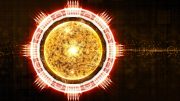


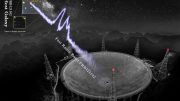
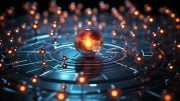

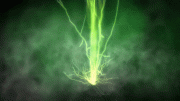
I can see that science is moving in a more lateral direction forward as compared to a star erupting scater collection of data, the assembly theory. Move forward with the collaborations, no need in having a competition of wit, each cogg on the gear has a importance of continuity. Leave no stone unturned.
Now entangle them and you got quantum wifi that works over vast distance.